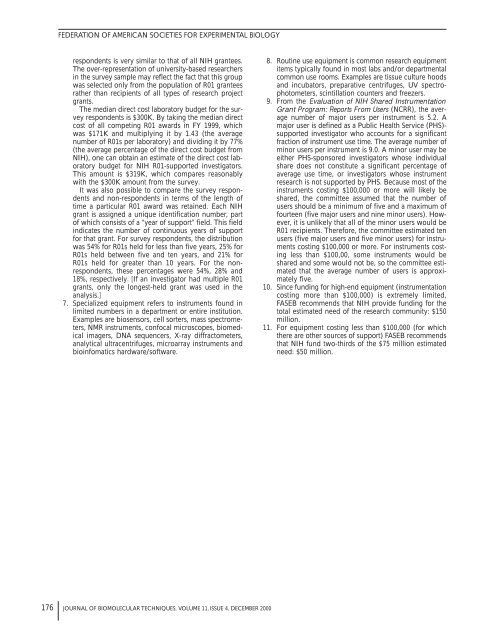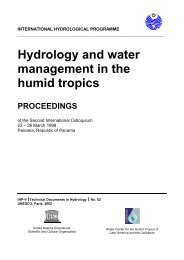FR AB - Science Reference
FR AB - Science Reference
FR AB - Science Reference
Create successful ePaper yourself
Turn your PDF publications into a flip-book with our unique Google optimized e-Paper software.
FEDERATION OF AMERICAN SOCIETIES FOR EXPERIMENTAL BIOLOGY<br />
respondents is very similar to that of all NIH grantees.<br />
The over-representation of university-based researchers<br />
in the survey sample may reflect the fact that this group<br />
was selected only from the population of R01 grantees<br />
rather than recipients of all types of research project<br />
grants.<br />
The median direct cost laboratory budget for the survey<br />
respondents is $300K. By taking the median direct<br />
cost of all competing R01 awards in FY 1999, which<br />
was $171K and multiplying it by 1.43 (the average<br />
number of R01s per laboratory) and dividing it by 77%<br />
(the average percentage of the direct cost budget from<br />
NIH), one can obtain an estimate of the direct cost laboratory<br />
budget for NIH R01-supported investigators.<br />
This amount is $319K, which compares reasonably<br />
with the $300K amount from the survey.<br />
It was also possible to compare the survey respondents<br />
and non-respondents in terms of the length of<br />
time a particular R01 award was retained. Each NIH<br />
grant is assigned a unique identification number, part<br />
of which consists of a “year of support” field. This field<br />
indicates the number of continuous years of support<br />
for that grant. For survey respondents, the distribution<br />
was 54% for R01s held for less than five years, 25% for<br />
R01s held between five and ten years, and 21% for<br />
R01s held for greater than 10 years. For the nonrespondents,<br />
these percentages were 54%, 28% and<br />
18%, respectively. [If an investigator had multiple R01<br />
grants, only the longest-held grant was used in the<br />
analysis.]<br />
7. Specialized equipment refers to instruments found in<br />
limited numbers in a department or entire institution.<br />
Examples are biosensors, cell sorters, mass spectrometers,<br />
NMR instruments, confocal microscopes, biomedical<br />
imagers, DNA sequencers, X-ray diffractometers,<br />
analytical ultracentrifuges, microarray instruments and<br />
bioinfomatics hardware/software.<br />
176 JOURNAL OF BIOMOLECULAR TECHNIQUES, VOLUME 11, ISSUE 4, DECEMBER 2000<br />
8. Routine use equipment is common research equipment<br />
items typically found in most labs and/or departmental<br />
common use rooms. Examples are tissue culture hoods<br />
and incubators, preparative centrifuges, UV spectrophotometers,<br />
scintillation counters and freezers.<br />
9. From the Evaluation of NIH Shared Instrumentation<br />
Grant Program: Reports From Users (NCRR), the average<br />
number of major users per instrument is 5.2. A<br />
major user is defined as a Public Health Service (PHS)supported<br />
investigator who accounts for a significant<br />
fraction of instrument use time. The average number of<br />
minor users per instrument is 9.0. A minor user may be<br />
either PHS-sponsored investigators whose individual<br />
share does not constitute a significant percentage of<br />
average use time, or investigators whose instrument<br />
research is not supported by PHS. Because most of the<br />
instruments costing $100,000 or more will likely be<br />
shared, the committee assumed that the number of<br />
users should be a minimum of five and a maximum of<br />
fourteen (five major users and nine minor users). However,<br />
it is unlikely that all of the minor users would be<br />
R01 recipients. Therefore, the committee estimated ten<br />
users (five major users and five minor users) for instruments<br />
costing $100,000 or more. For instruments costing<br />
less than $100,00, some instruments would be<br />
shared and some would not be, so the committee estimated<br />
that the average number of users is approximately<br />
five.<br />
10. Since funding for high-end equipment (instrumentation<br />
costing more than $100,000) is extremely limited,<br />
FASEB recommends that NIH provide funding for the<br />
total estimated need of the research community: $150<br />
million.<br />
11. For equipment costing less than $100,000 (for which<br />
there are other sources of support) FASEB recommends<br />
that NIH fund two-thirds of the $75 million estimated<br />
need: $50 million.















